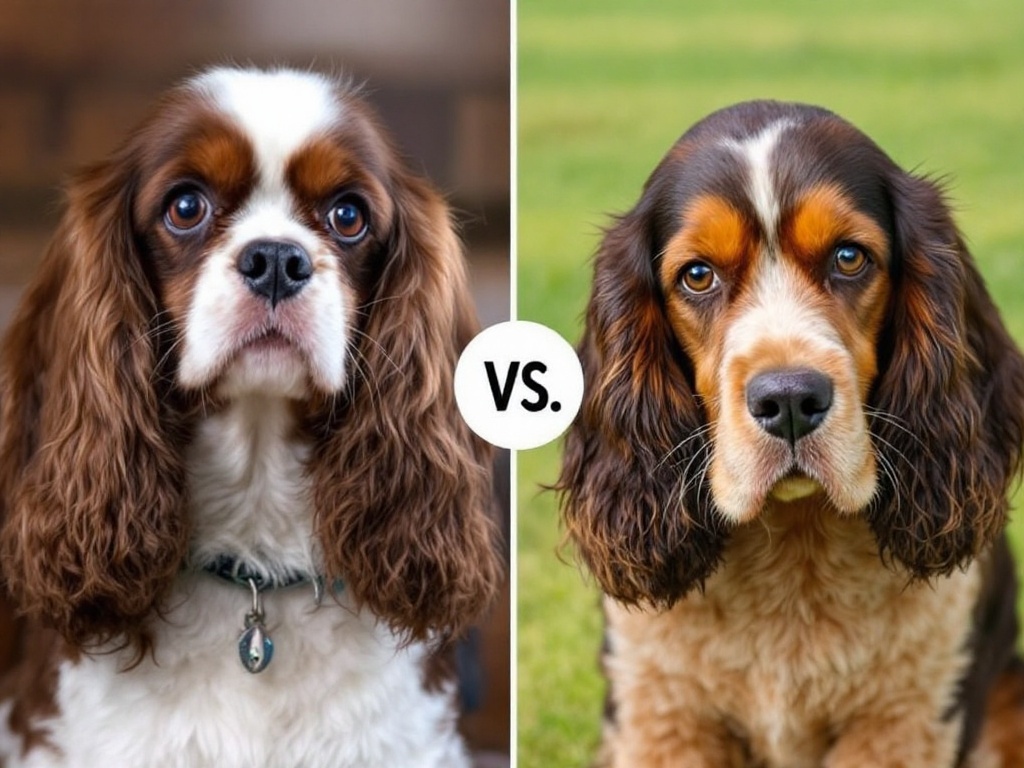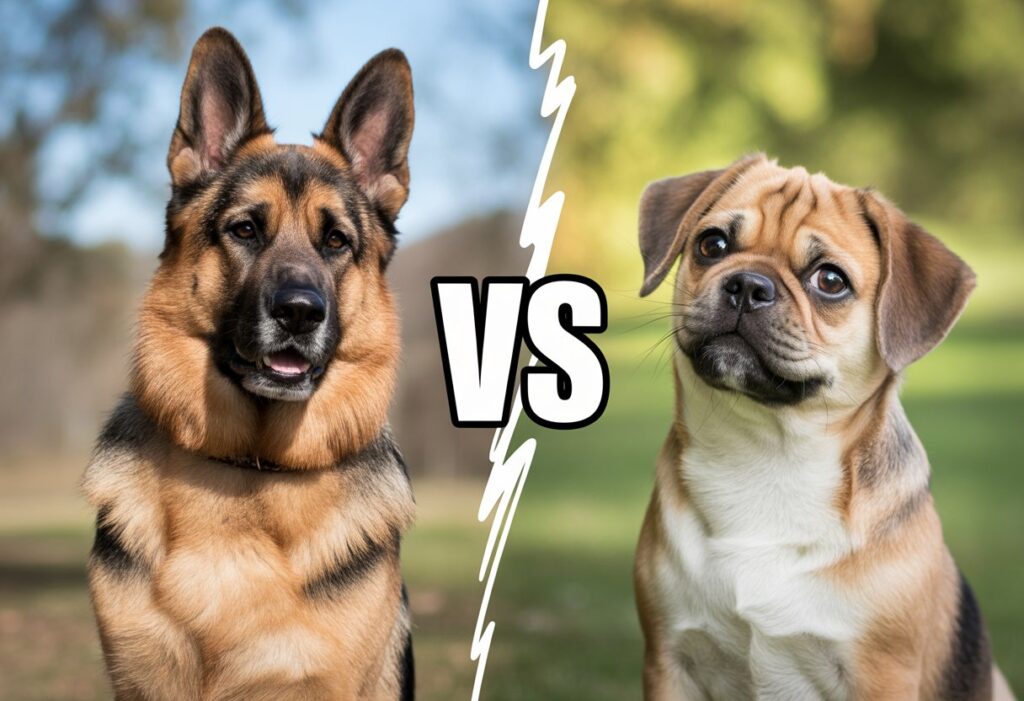Choosing between the Cavalier King Charles Spaniel and the American Cocker Spaniel isn’t easy if you’re after a friendly, loyal companion but can’t decide which fits your lifestyle. The biggest differences between these two dogs are their grooming needs, personalities, activity levels, and health risks, all of which can shape your daily life.
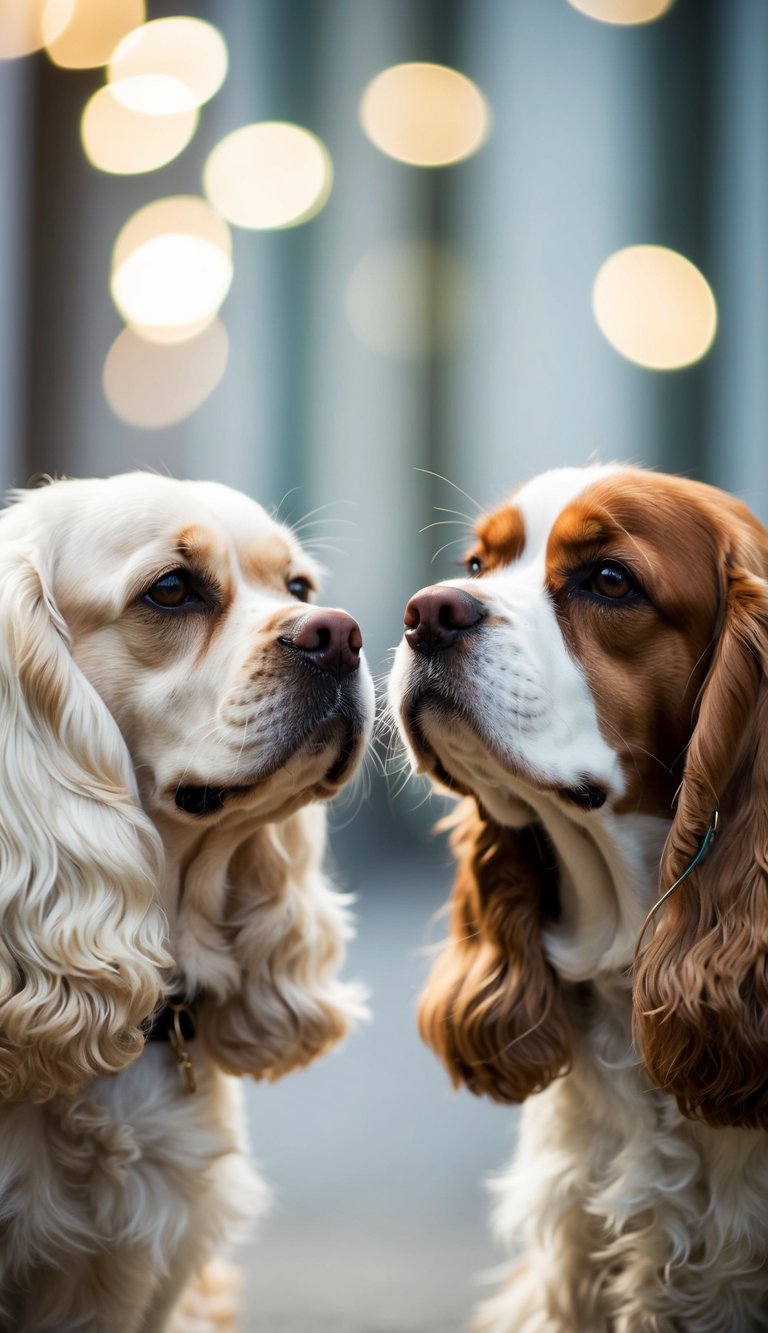
Both breeds are loving and gentle, but you’ll spot clear differences in their size, look, and energy. The Cocker Spaniel usually acts more athletic and playful, while Cavaliers adjust well to both quiet and lively homes.
If you want to dig deeper into their quirks and how they fit with different households, check out a full breed comparison.
Origins and Breed History
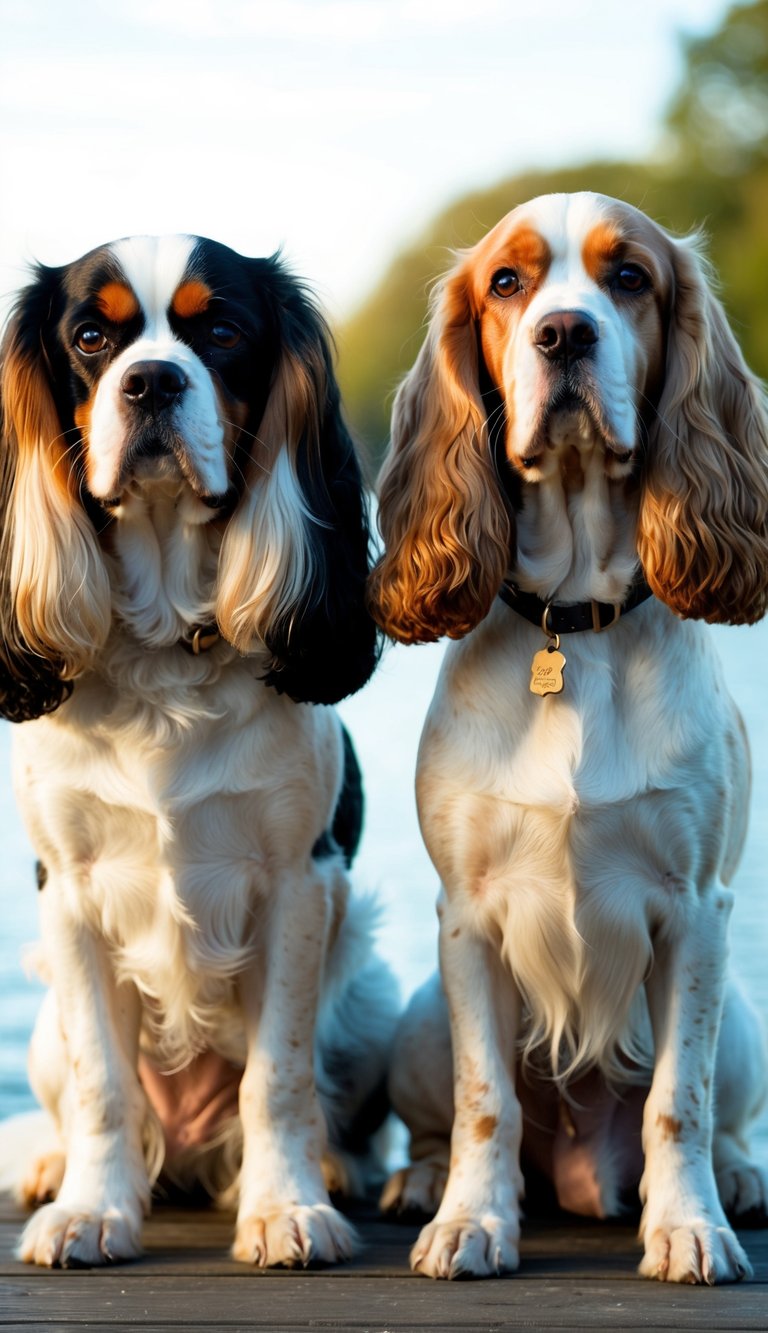
The Cavalier King Charles Spaniel and the American Cocker Spaniel each have their own long, quirky histories. They were shaped in different countries for different jobs, which led to some big differences in looks, purpose, and personality.
Cavalier King Charles Spaniel Background
The Cavalier King Charles Spaniel got its name from King Charles II of England. It started out in the 17th century and quickly became a favorite in royal courts, mostly because of its gentle, friendly vibe.
These spaniels were bred as lap dogs, not hunters. You’ll spot them in old paintings, hanging out with noble families or just lounging at their feet.
Their small size and calm nature made them a hit with the upper class. Breeders kept the Cavalier’s sweet face and those long, floppy ears over the years.
The breed hasn’t changed much, still holding onto that classic look and loving personality. If you love the idea of a dog with royal roots and a knack for companionship, the Cavalier King Charles Spaniel has that charm. You can learn more about its history at A-Z Animals’ Cavalier King Charles Spaniel overview.
American Cocker Spaniel Development
The American Cocker Spaniel traces back to the English Cocker Spaniel. When it came to America in the 1800s, breeders focused on traits for hunting birds like woodcock.
In the U.S., people bred a smaller, rounder-headed spaniel. This set the American Cocker apart from its English relatives.
They aimed for good looks and a gentle temperament, which made the breed popular as both a hunter and a family pet. By the mid-1900s, the American Cocker Spaniel stood on its own.
It got recognized by American kennel clubs and became a favorite at dog shows. For more on how breeders shaped the breed, check out Dogster’s Cocker Spaniel comparison.
Differences from English Cocker Spaniel
The American and English Cocker Spaniels share ancestors, but their paths split long ago. American Cockers are usually smaller, have a shorter muzzle, and a fuller coat.
English Cockers tend to be bigger, with longer faces and a leaner build. They were bred to hunt more types of game and have a stronger work drive.
American Cockers, bred mainly for birds and companionship, don’t show as much hunting instinct these days. Their look and attitude reflect that.
The breeds officially split when standards changed in the early 1900s. Now, kennel clubs recognize them as separate breeds. If you’re curious about how the spaniel family evolved, visit the American Kennel Club’s spaniel dog breeds.
Physical Appearance Comparison
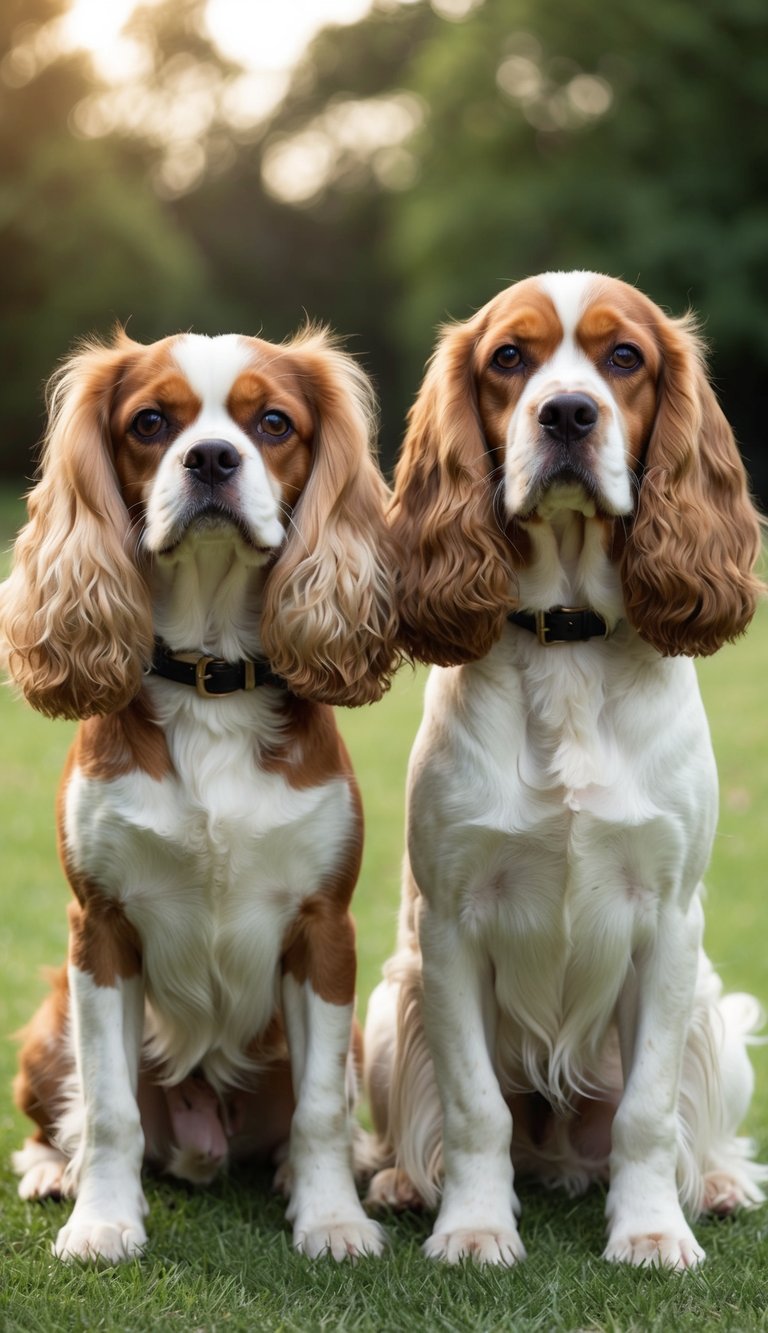
Both the Cavalier King Charles Spaniel and the American Cocker Spaniel have those soft, flowing coats and expressive faces. Still, they’re different in size, build, and the little details.
Size and Build
The American Cocker Spaniel is bigger. Adults usually stand 13.5 to 15.5 inches tall at the shoulder and weigh between 20 and 30 pounds.
Cavalier King Charles Spaniels are smaller and lighter. Most are about 12 to 13 inches tall and weigh 13 to 18 pounds.
You’ll notice the Cocker Spaniel has a sturdy, athletic build. Cavaliers look more delicate and graceful. More about their size and build here.
Silky Coat Characteristics
Both breeds have beautiful coats, but they’re not quite the same.
The Cavalier King Charles Spaniel’s coat is long, silky, and mostly straight. Their hair flows, especially on the ears, chest, legs, and tail. It feels soft and just needs regular brushing.
American Cocker Spaniels also have silky coats, but they’re denser, with more wave or even a slight curl. Their hair can get heavy around the chest and legs and needs more trimming to keep it neat. Grooming is a bigger job with Cockers since their thick coat tangles easily.
Colors are different, too. Cavaliers come in four main colors, while Cockers have more options—solid, parti-color, and roan. For more on coats, see this silky coat comparison.
Distinctive Facial Features
Cavalier King Charles Spaniels have a gentle, rounded face and big, dark, round eyes. People often call their expression sweet and endearing. Their long ears sit high and are covered in wavy hair.
American Cocker Spaniels have a broader skull and a shorter, squarer muzzle. Their eyes are round and dark, too, but set deeper, giving them a more alert look.
Both breeds have long, floppy ears, but the Cocker’s ears are thicker and more heavily feathered. This frames their face differently than the Cavalier’s lighter, airier ears. You can compare their faces at Cocker Spaniel vs Cavalier King Charles Spaniel.
Temperament and Personality
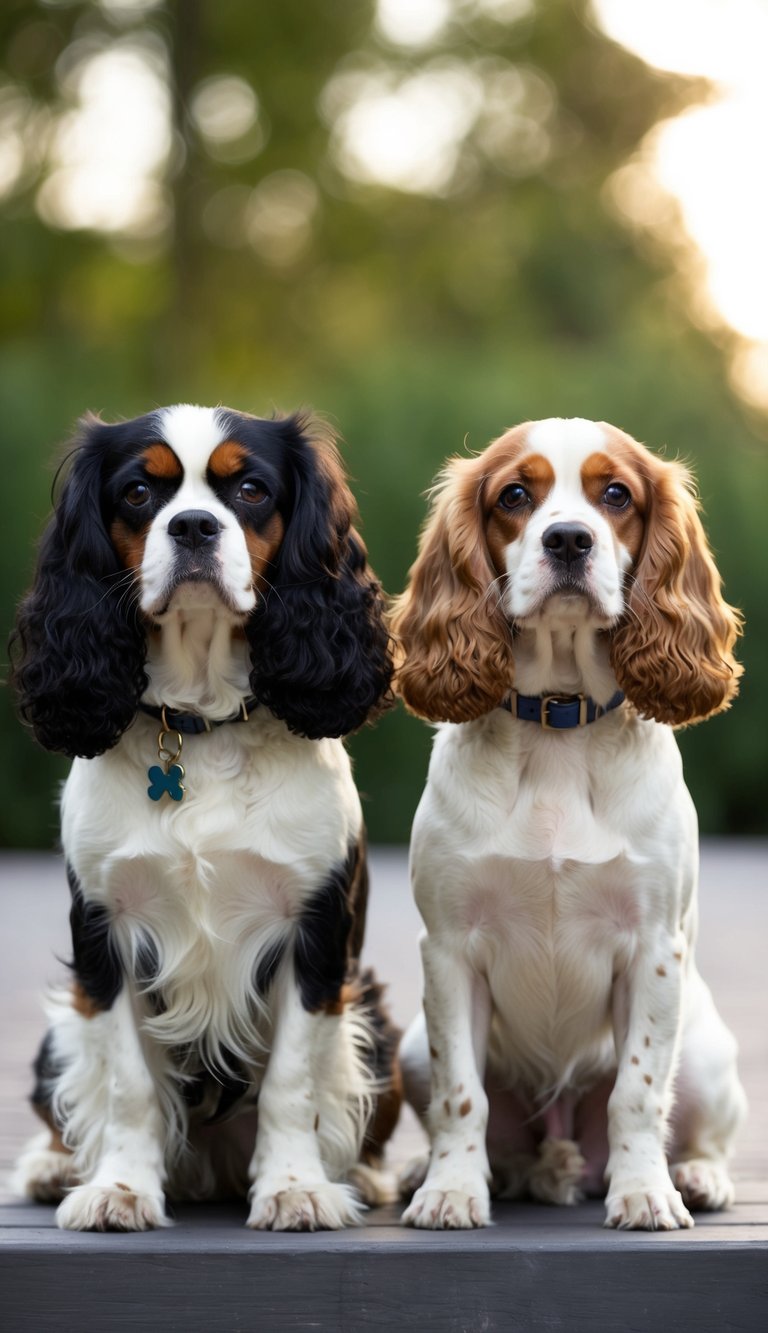
Cavalier King Charles Spaniels are gentle and flexible, sliding into different home environments without much fuss. American Cocker Spaniels are cheerful and social, but their working dog roots still show up in how they act around people and other animals.
Family Compatibility
Cavalier King Charles Spaniels are affectionate and patient. They bond closely with their families and can handle both busy and laid-back households.
Their gentle nature makes them great for homes with kids—they’re playful but not aggressive. American Cocker Spaniels love being around people and crave attention.
They’re lively and want to join in on family fun. They get along with children, but they can be sensitive if play gets too rough.
Both breeds want to be included in daily life and don’t like being left alone for long stretches. If your family is often away, you might run into some separation anxiety or boredom issues. For a flexible, loving buddy, Cavaliers are a solid pick. If you want a dog that brings energy and excitement but needs some guidance, the Cocker Spaniel could be your match.
Interaction with Other Pets
Cavalier King Charles Spaniels usually get along with other dogs and pets. Their easygoing attitude means they don’t get territorial.
Early socialization helps, but most Cavaliers are naturally friendly with new animals. American Cocker Spaniels are pretty sociable, especially if they grow up with other dogs.
Their playful energy can sometimes lead to chasing or rough play, so it’s smart to supervise at first. Small pets like hamsters or birds might spark curiosity, but aggression is rare in Cockers.
If you have cats, Cavaliers usually handle them well, while Cockers might need more time to learn the rules. Slow introductions and good experiences with other pets work best for both breeds. Exposing puppies to different animals early helps things go smoothly.
Prey Drive and Instincts
Cavalier King Charles Spaniels have a low prey drive. They were bred as companions, not hunters, so you won’t see them chasing small animals much.
Some curiosity is normal, but it rarely gets intense. Walks are usually calm, and teaching recall is pretty straightforward.
American Cocker Spaniels were bred as working dogs and hunters, so their prey drive is moderate. They might chase squirrels, birds, or rodents on walks.
You’ll want to train them with strong recall commands if you let them off-leash. If you’d rather not worry about your dog chasing everything that moves, the Cavalier is a safer bet.
Still, the Cocker Spaniel’s instincts can be managed with games and puzzle toys. Keeping their mind busy helps them stay chill and uses up that hunting energy.
Exercise and Activity Needs

Cavalier King Charles Spaniels and American Cocker Spaniels both need daily exercise, but they don’t need the same amount or type of activity. Knowing these differences can help you choose which breed actually fits your day-to-day life.
Daily Exercise Requirements
The Cavalier King Charles Spaniel usually needs at least 30 minutes of activity each day. Walks, gentle yard play, or even indoor games all count.
Cavaliers love being with you, so most are content just hanging out and joining whatever you’re doing.
American Cocker Spaniels, on the other hand, need a lot more exercise—think 60–90 minutes daily. Walks, games of fetch, and sometimes even agility or running are great for them.
If Cockers don’t get enough activity, you’ll probably see bored behaviors like digging or chewing.
Here’s a quick look at the difference:
| Breed | Daily Exercise Time |
|---|---|
| Cavalier King Charles Spaniel | 30+ minutes |
| American Cocker Spaniel | 60–90 minutes |
Cocker Spaniels just have more energy. Their working dog roots mean they’re always up for a challenge—way more so than Cavaliers.
Suitability for Active Lifestyles
Love long walks, running, or playing sports with your dog? The American Cocker Spaniel is usually the better fit for that vibe.
This breed keeps up with active routines and genuinely thrives on regular challenges—both mental and physical.
The Cavalier King Charles Spaniel is more adaptable. They’ll happily join you for a longer walk or a hike, but short, gentle routines are fine too.
If your schedule is packed or you just like to chill, Cavaliers fit right in. They’re happy with relaxed activities.
Outdoor-loving families or people who are always on the move will probably prefer a Cocker Spaniel. If you want a companion for moderate activity who’s also cool with lazy days indoors, the Cavalier is a great pick.
For more about their activity needs, check out PetsRadar.
Grooming and Coat Maintenance
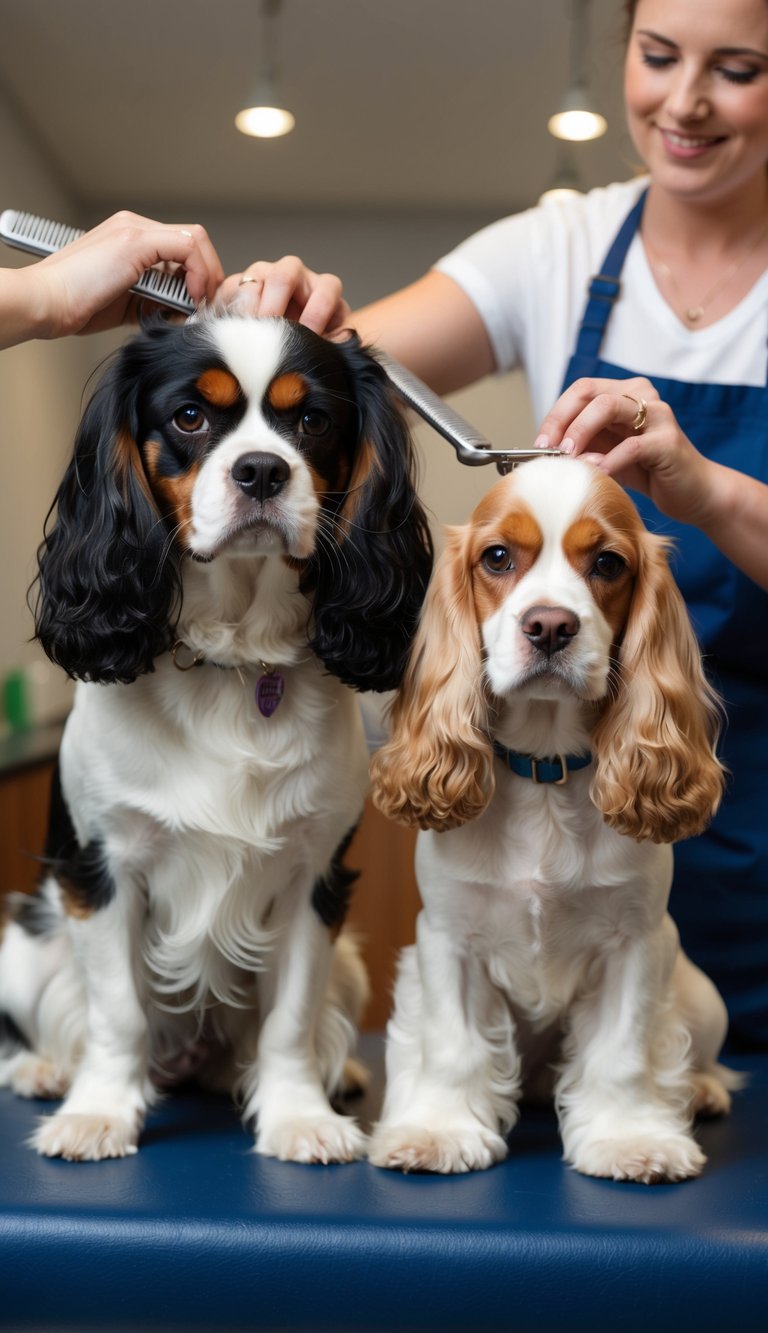
Both breeds have gorgeous, silky coats that really need regular care. Keeping up with grooming is key if you want your dog’s coat shiny and their skin healthy.
Brushing and Shedding
Both shed, but you’ll notice the difference. American Cocker Spaniels shed more, especially when the seasons change.
Their thick undercoat tangles and mats fast if you don’t brush daily.
Cavalier King Charles Spaniels have a finer, silkier coat. They shed a little less, and brushing two or three times a week usually does the trick.
Pay extra attention behind the ears and under the legs—mats pop up there in no time.
A slicker brush and a metal comb work well for both breeds. Regular brushing gets rid of loose hair and spreads natural oils for a soft, shiny coat.
It also gives you a chance to spot skin problems early.
Trimming and Professional Grooming
Cocker Spaniels need more trimming and professional grooming. Their longer, fuller coat (especially the feathering on legs and belly) means a haircut every four to six weeks.
If you skip trims, their coat traps dirt and moisture, which can lead to skin trouble.
A groomer will tidy up paws, ears, and sanitary spots to prevent mats. Cockers’ ears need frequent checks, since they’re prone to infections if you let them get messy.
Cavalier King Charles Spaniels don’t need as much trimming. Some folks snip the feet and feathering to keep things neat.
Most Cavalier grooming is easy to handle at home. Still, a pro groomer can help out if you’re not confident with scissors.
You’ll find more details in this comparison guide.
Health and Lifespan

Cavalier King Charles Spaniels usually live longer, while American Cocker Spaniels can run into more health issues. Early health checks and keeping up with vaccines and care help both breeds.
Common Genetic Concerns
Cavalier King Charles Spaniels often develop heart problems, especially mitral valve disease as they get older. This can start young and turn serious if you don’t keep an eye on it.
Other Cavalier issues include syringomyelia (a nervous system problem), hip dysplasia, and eye disorders like cataracts.
American Cocker Spaniels face a different set of risks. Their long, floppy ears make ear infections common.
They also get eye problems like glaucoma and cataracts, and skin allergies pop up more often. Some Cockers deal with hip dysplasia and autoimmune diseases.
Regular health checks help you catch these things early and could mean a longer life for both breeds.
Routine Veterinary Care
Routine vet visits matter for both breeds. Annual check-ups, vaccines, and dental cleanings help you spot and prevent issues early.
Cavaliers benefit from regular heart and eye exams, since these problems show up with age.
American Cocker Spaniels need extra ear care. Clean and check their ears often to head off infections.
Eye exams and skin checks should be part of their routine too. Feeding high-quality dog food and keeping their weight in check helps both breeds’ joints.
Good care habits really do make a difference in keeping your dog healthy and active.
Training and Intelligence
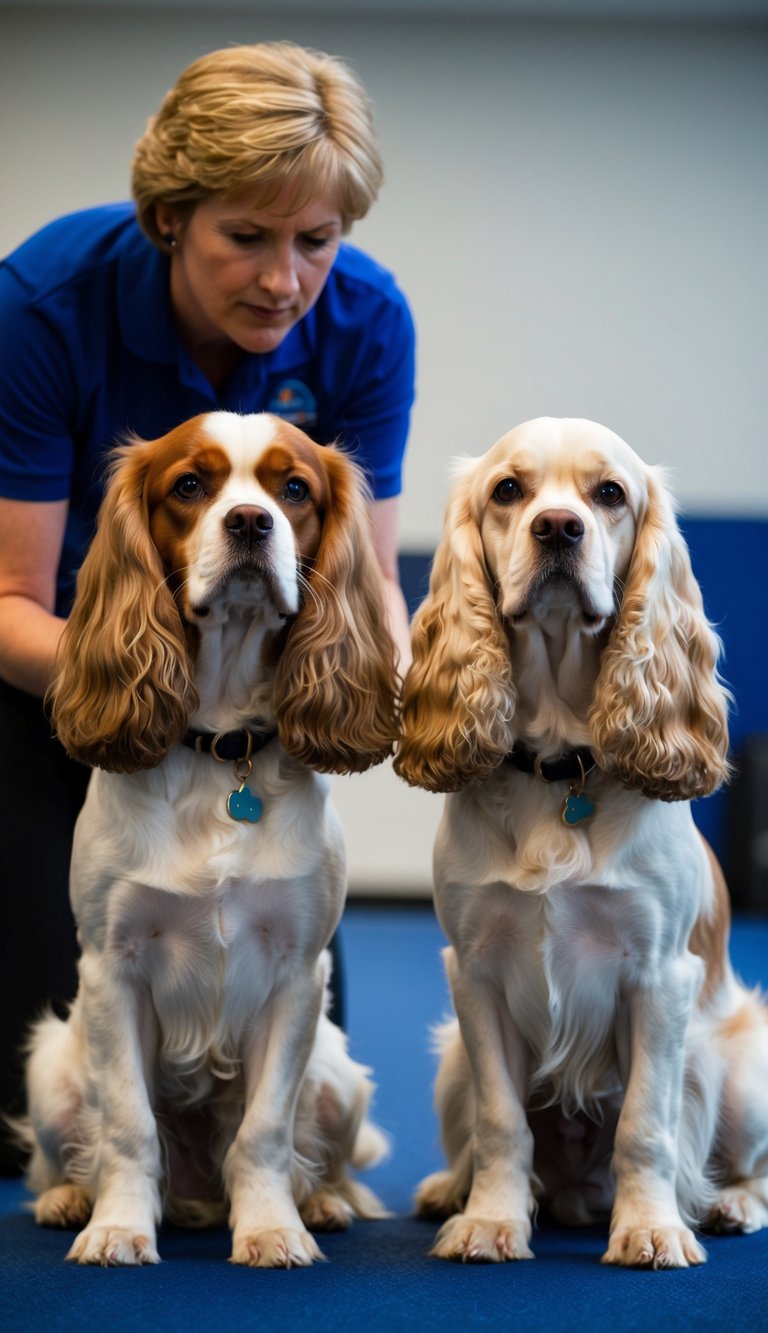
Both Cavaliers and American Cockers are smart, so training usually goes well whether you want a family dog, a therapy companion, or even a working dog. The ease of training and the challenges you might hit are a bit different, though.
Trainability
Cavalier King Charles Spaniels love gentle, positive training. They want to make you happy and pick up commands quickly, especially if treats or praise are involved.
American Cocker Spaniels are also super trainable and show off some real problem-solving skills. Their hunting and working background means they can learn everything from basic manners to advanced agility.
Cockers thrive with consistent routines and clear expectations.
Both breeds do best when you start socialization early. Short, upbeat sessions seem to stick better.
Regular practice helps Cavaliers and Cockers remember what they’ve learned. If you want to dig deeper into their training abilities, check out this breed comparison.
Behavioral Challenges
Even smart dogs have their quirks. Cavaliers can be sensitive and get distracted if you’re too harsh—positive reinforcement is definitely the way to go.
American Cocker Spaniels sometimes get stubborn, especially if they don’t get enough exercise or mental stimulation. They need both every day to avoid mischief.
Both breeds can struggle with separation anxiety if left alone too long, which leads to barking or destructive behaviors. Early crate training and teaching a bit of independence can help.
Cavaliers need gentle handling to avoid becoming fearful. Cockers need firm but kind guidance so they don’t get willful.
If you want more on their personalities and training differences, here’s a detailed breed comparison.
Living Conditions and Adaptability
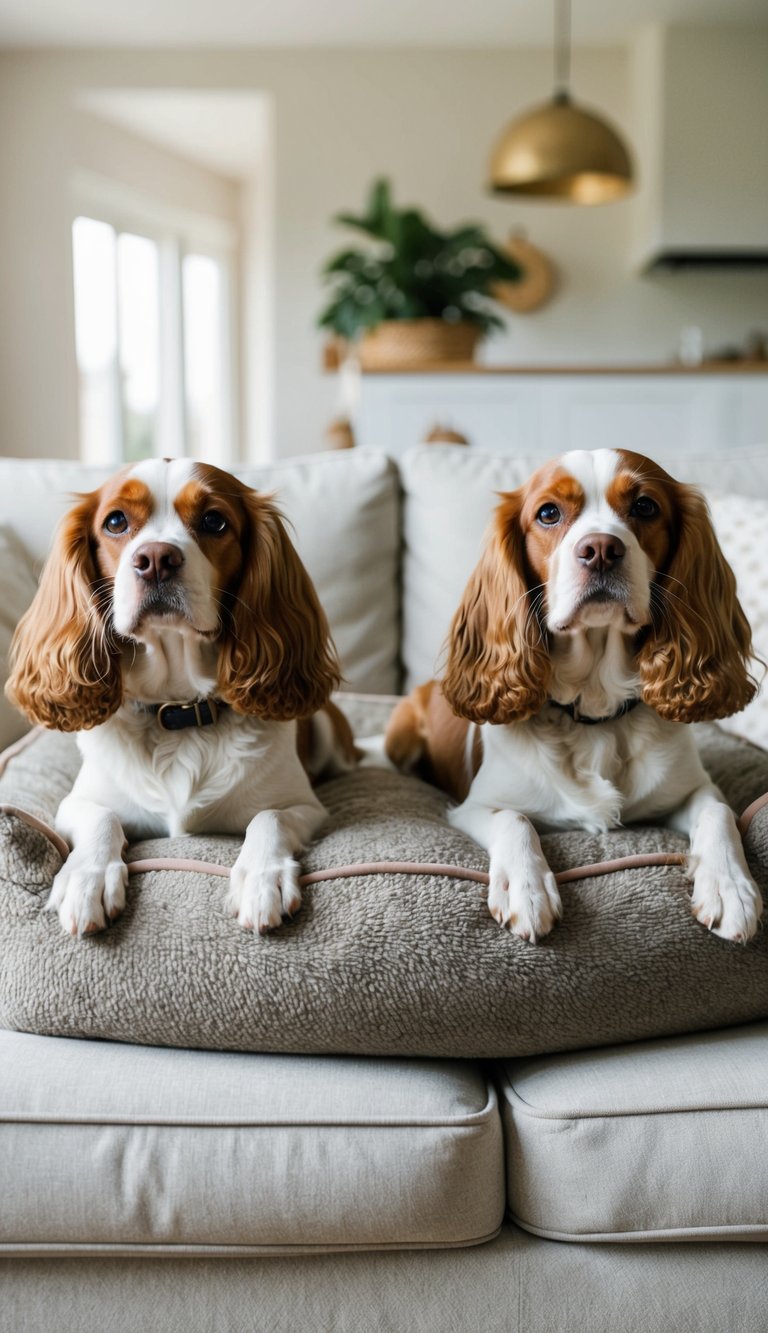
Both the Cavalier King Charles Spaniel and American Cocker Spaniel can adapt to lots of living situations. Their comfort depends a lot on your space and the local weather.
Apartment Versus House Living
Cavalier King Charles Spaniels are small and pretty chill. They’re a good pick for apartments or smaller homes.
As long as you give them attention and daily exercise, they’re happy. Cavaliers don’t bark much, which is a plus if you’ve got neighbors nearby.
American Cocker Spaniels are bigger and have more energy. They love having a yard but can do fine in apartments if you make time for play and walks.
A bored Cocker might get noisy or pick up some bad habits.
Both breeds want company and don’t like being left alone for long. Walks, playtime, and hanging out keep them content, whether you’ve got a big house or a tiny flat.
For more on how they adapt to different homes, check this side-by-side comparison.
Climate Tolerance
Cavalier King Charles Spaniels have thin, silky coats and can get cold fast. In winter, they might need a sweater or extra warmth.
Hot weather is tough for them too—always make sure they’ve got water and shade.
American Cocker Spaniels have a thicker, denser coat, which gives a bit more weather protection. Still, their long fur can make them overheat in summer.
Regular brushing helps them stay cooler and prevents mats.
Neither breed handles extreme heat or cold well. Watch the temperature, keep outdoor time short in harsh weather, and look out for signs of overheating or chills.
For more on climate needs, see this detailed breed comparison.
Popularity and Recognition
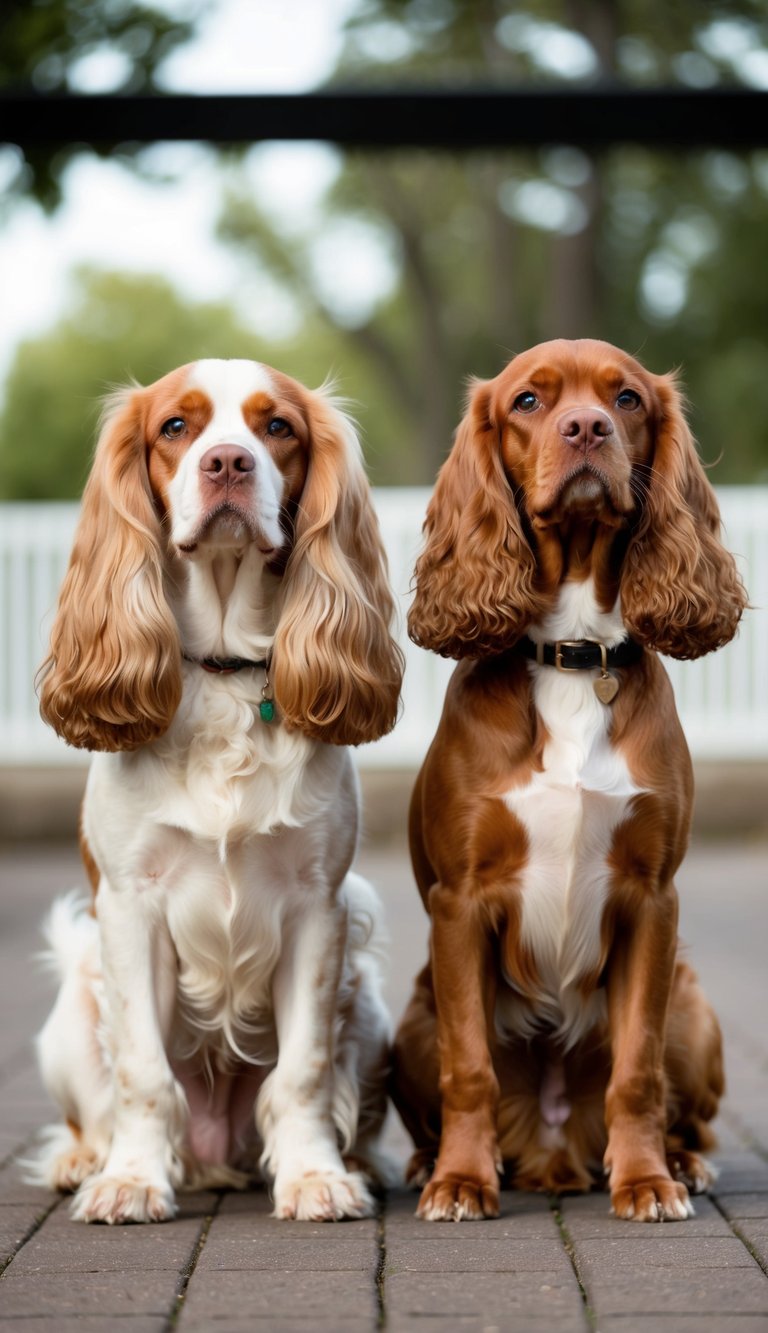
Both the American Cocker Spaniel and Cavalier King Charles Spaniel have their fan clubs and are easy to spot. Kennel clubs and breed organizations keep their standards clear, which helps keep these breeds true to type.
Global Popularity Trends
The American Cocker Spaniel was the top dog in the US for years in the late 1900s. Its playful personality and classic looks made it a family favorite.
It’s still pretty popular, especially with people who want an affectionate, trainable companion.
The Cavalier King Charles Spaniel started out as a European lapdog but has become popular all over. In the UK, it’s a classic—often linked with royalty.
Over the past two decades, Cavaliers have become one of the most wanted companion breeds in Australia, Canada, and the US. Their sweet nature and small size are a big draw for city folks and anyone after a gentle friend.
You’ll spot both breeds in ads and media all the time, which definitely keeps them in the spotlight.
Breed Club Standards
Both breeds show up on the rosters of major kennel clubs, like the American Kennel Club (AKC) and The Kennel Club (UK). The AKC spells out standards for the American Cocker Spaniel, highlighting a rounded head, soulful eyes, and a silky, flowing coat.
These guidelines help breeders aim for the ideal look and temperament in show dogs. For the Cavalier King Charles Spaniel, clubs get specific about size, head shape, eye spacing, and those classic coat markings.
The breed’s supposed to look noble and have a warm, social vibe. Only four colors make the cut: Blenheim, tricolor, ruby, and black & tan.
Breed clubs team up with owners and breeders to encourage good practices and preserve health and temperament. If you want all the nitty-gritty details, check out this Cocker Spaniel vs Cavalier King Charles Spaniel guide.
Choosing the Right Breed for You
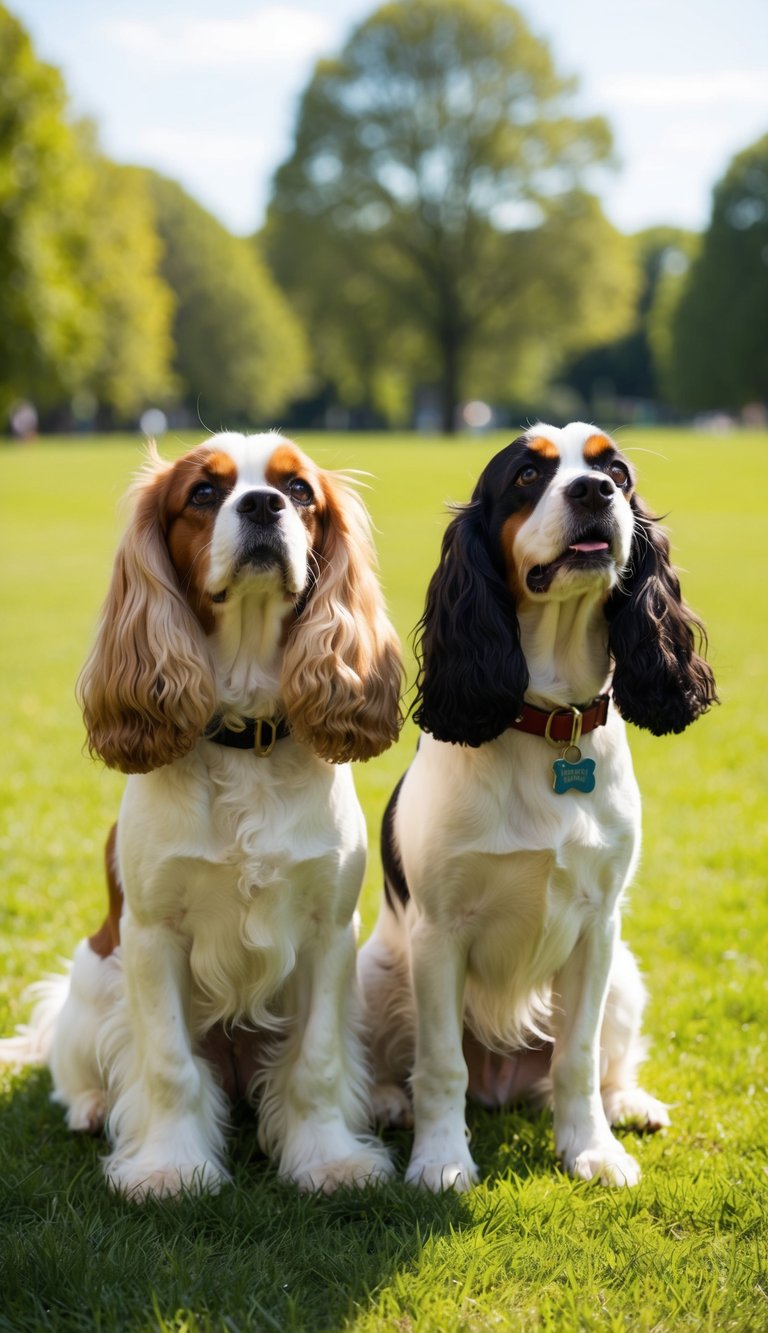
Both the Cavalier King Charles Spaniel and the American Cocker Spaniel are loving dogs, but they don’t fit every lifestyle. Size, personality, and care needs can really shift how they mesh with your day-to-day routine.
Lifestyle Considerations
If you’re busy or want a laid-back buddy, the Cavalier King Charles Spaniel might just be your speed. These pups are small and fit right into apartments or houses.
They’re flexible about activity and usually stay content with short daily walks. American Cocker Spaniels, on the other hand, have more energy and need more playtime.
If hiking or jogging is your thing, a Cocker Spaniel could keep up and then some. Their bigger size and thick coat mean more grooming—expect to set aside time each week for that.
| Trait | Cavalier King Charles Spaniel | American Cocker Spaniel |
|---|---|---|
| Energy Level | Moderate | High |
| Space Needs | Small homes or apartments | Best with more space |
| Grooming | Moderate (regular brushing) | High (professional grooming recommended) |
| Adaptability | High | Moderate |
For more about their personalities and exercise needs, here’s another Cocker Spaniel vs Cavalier King Charles Spaniel breed comparison.
Suitability for First-Time Owners
Cavalier King Charles Spaniels feel gentle, easygoing, and pretty eager to make their humans happy. Their simple needs and sweet nature usually make things easier for first-time dog owners.
They don’t throw too many training curveballs and tend to settle into new routines without much fuss. American Cocker Spaniels are friendly too, but sometimes they’re a bit stubborn or sensitive.
They’ll need positive training and some patience, especially as puppies. That long, silky coat? It demands frequent brushing and trips to the groomer or it’ll mat up fast.
If you’re new to dogs, all the grooming and training for a Cocker Spaniel might feel like a lot. Both breeds are family-friendly, but Cavaliers generally ask for less.
You can dig deeper into the differences with this American Cocker Spaniel vs Cavalier King Charles Spaniel comparison.
Breed Comparisons with Other Dogs
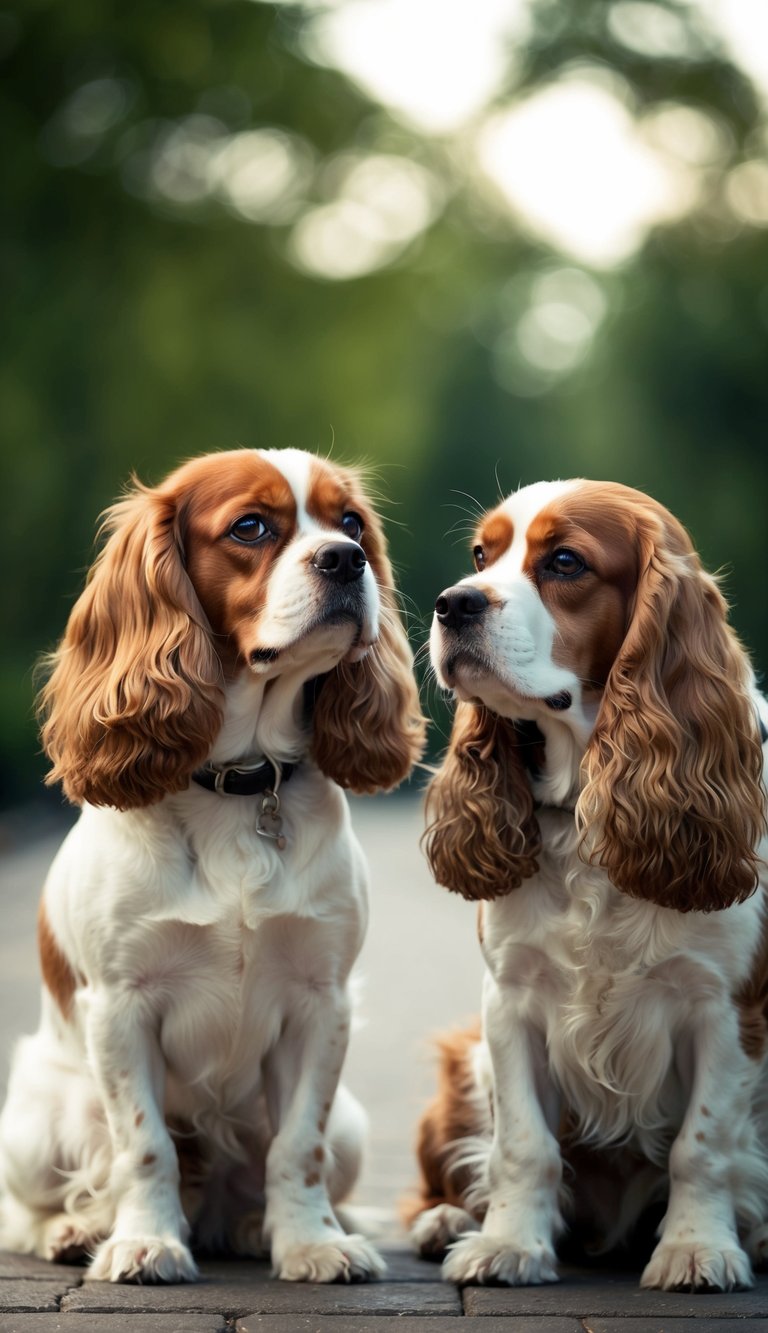
Every breed has quirks that make it fit some homes better than others. Size, grooming, and temperament—these things really matter when you’re picking a new buddy.
Miniature Schnauzer Differences
The Miniature Schnauzer stands out with its wiry coat, bushy eyebrows, and that unmistakable beard. Cavaliers and Cocker Spaniels have soft, long coats that need regular brushing, but the Schnauzer’s coat needs hand-stripping or clipping to stay tidy.
Energy-wise, Miniature Schnauzers are alert, lively, and sometimes a little bossy. Cavaliers are all about cuddles and people, while Cocker Spaniels split the difference—playful but also affectionate.
Miniature Schnauzers act like confident watchdogs and can be pretty vocal. If you want a dog that’ll let you know when someone’s at the door, a Schnauzer might be the ticket.
Cavaliers and Cocker Spaniels tend to get along with most people and dogs. Schnauzers sometimes need extra socialization as pups, just to make sure they stay chill in new places.
All three breeds are small, but the Miniature Schnauzer looks a bit squarer and sturdier. If you’re after a pet with a tougher build and a look that turns heads, the Schnauzer is worth a thought.
Privacy and Data Use Considerations for Dog Owners
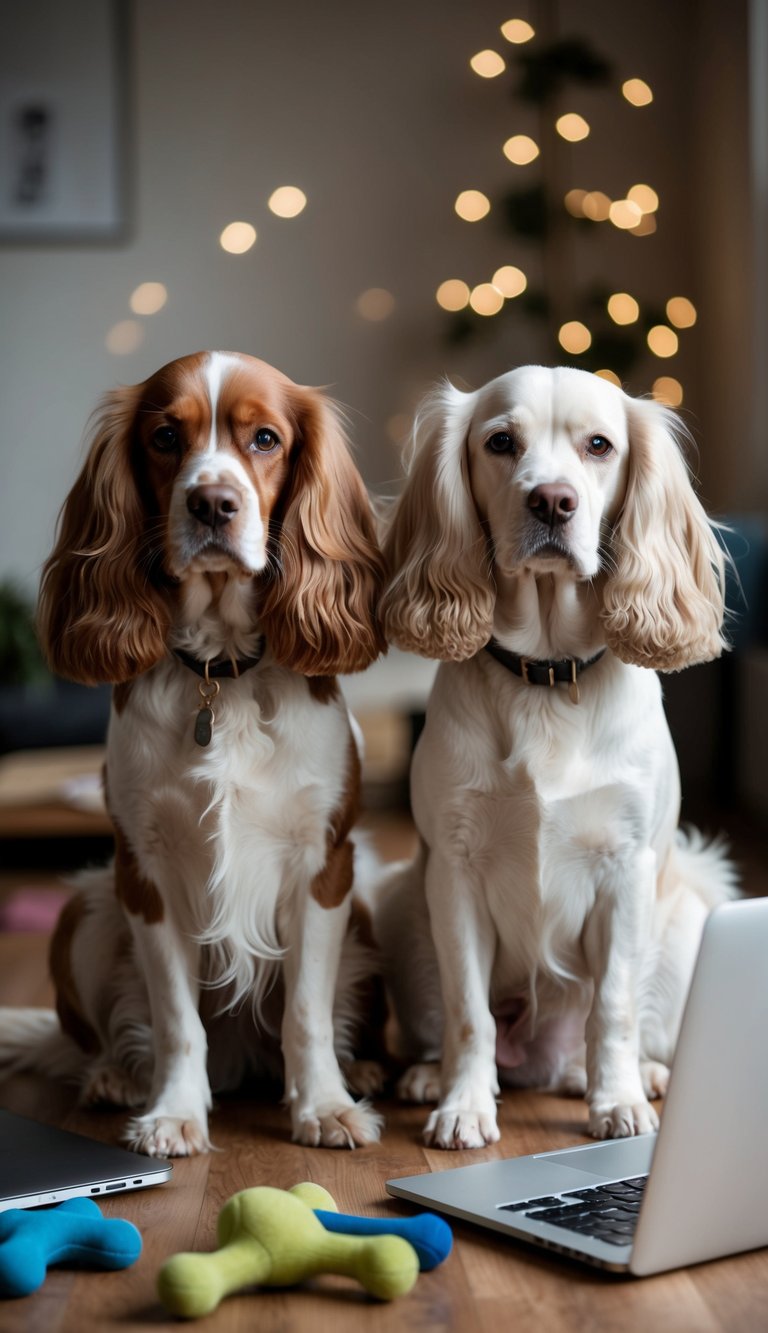
When you visit dog breed comparison sites or use pet services online, your privacy and data can come into play. Understanding cookies, what data gets used, and your privacy controls can help you stay safer online.
Cookie Policy Awareness
Dog breed websites often drop cookies on your device. These little files remember your settings and help sites show you ads, measure content, and figure out what visitors like.
Sites might track which pages you visit or help you stay logged in. Companies like Yahoo use cookies for things like authenticating users and blocking spam.
Cookies can also help develop better services and improve your experience. You can usually read a site’s cookie policy to see what gets collected.
Most sites let you accept or reject cookies. If you don’t want certain data tracked, take a look at the privacy notice and adjust those settings.
Personal Data and Geolocation Data
Pet websites might ask for your name, email, search history, or even your IP address. They use this for things like creating accounts, signing you up for newsletters, or showing you local content.
Some services collect geolocation data to point you toward nearby trainers or pet shops. That can be handy, but sharing your location can risk privacy if you’re not careful.
Usually, security measures like encryption and access controls keep your info safe. If you use location-based features, check what data the site collects and how long it sticks around.
If privacy matters to you, don’t be shy about limiting what you share.
Consent Framework and Privacy Settings
Most modern websites ask for your approval before collecting data. You’ll usually see a pop-up or banner that lets you tweak privacy settings for cookies, ads, content measurement, and other stuff.
You can pick which data types to allow or block. Maybe you just want essential cookies, or you’d rather turn off geolocation—totally your call.
It’s smart to check privacy controls every so often, especially if a site updates its policy. Adjust your preferences whenever you feel like your privacy needs a tune-up.

